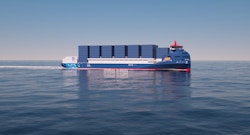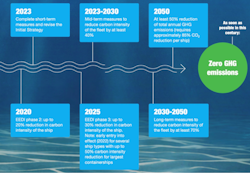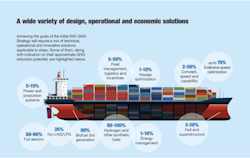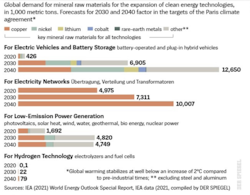Energy Observer 2, a demonstrator vessel that runs on liquid H2
Maritime transport has the particularity of having a significant impact on the environment and the climate while also being of major importance for the global economy. The announcement of Energy Observer 2 during the One Ocean Summit emphasizes the importance of reducing the maritime transport’s carbon footprint, starting with fuels.
Liquid hydrogen produced from renewable energies is the selected fuel of our new demonstrator vessel, to drastically reduce polluting emissions during navigation. Explanations with Dr Katia Nicolet, on-board scientist.

Energy Observer 2
Today's maritime transport is a sector of crucial importance for the global economy of our modern society. 80% of goods, in terms of volume, are transported on our seas: clothes, objects of all kinds, automobiles, spare parts, but also and above all, materials, food and fuel. Today there are nearly 100,000 commercial vessels of all sizes on our seas, ranging from 30m long passenger ferries to gigantic tankers over 450m long. All these ships represent a total deadweight of 2.13 billion tons, of which 43% are bulk carriers, cargo and multipurpose cargo ship (the type of ship that will be Energy Observer 2), and 29% tankers, illustrating the importance of unprocessed products (ores, steel, wood, sand, wheat, grains etc.) and fuels (oil and coal) for world trades.
If you have a roof over your head, if you own a car, if you use gas for heating, if you have a mobile phone or if you wear clothes made in Asia, you depend on maritime traffic to live.
Halve GHG emissions by 2050
Obviously, the presence of these ships has a considerable impact on the ocean and the planet as a whole. First of all, these ships still use fossil fuels for propulsion: heavy fuel oil, diesel or liquefied natural gas (methane). The International Maritime Organization's study (IMO), dating from 2020, estimates between 250 and 300 million tons of fuel consumed per year, for an annual 1,076 million tons of CO2 emissions. It is difficult to understand this figure and its consequences for the climate. To give an idea, this is equivalent to 2.9% of global anthropogenic CO2 emissions. If maritime transport were a country, it would be the sixth most polluting in the world, just after Japan and ahead of Germany.

"What we aim for with #EnergyObserver2 is to gather the best industrials to develop a medium-sized multi-purpose cargo ship that sails without emissions." @VicErussard at the #OneOceanSummit @ClusterMaritime @MerGouv @IMOHQ #PFUE2022 @EODev_H2
Despite its considerable impact on the planet, maritime transport is rarely mentioned during climate debates, largely due to its major importance for the economy, but also because of it efficiency per ton of goods transported compared to road or air transport. Furthermore, it is legally complex to harmonize international regulations and impose global governance when these commercial vessels come from over 35 different countries. The IMO, the specialized agency of the United Nations, has been responsible, among other things, for preventing pollution of the seas by commercial ships since 1948. Recently, the IMO has reinforced its objectives for greenhouse gases (GHG) emission reductions, the goal being to halve the total annual GHG emissions by 2050. An ambitious objective that will not be achieved without the implementation of various operational solutions and technical innovations.
Regulate, innovate, transform
To assess current emissions and determine whether the strategies put in place are effective in reducing pollution generated by ships, the IMO has defined a unit of carbon intensity. Carbon intensity is the quantity of CO2 emitted (in grams) per ton of goods transported over one nautical mile (gCO2/t/nm). In 2008 -the baseline year for IMO targets- ships emitted an average of 17g of CO2 per ton transported over one mile. In 2018, this figure was reduced to 11.7g of carbon intensity. However, over the same period, global CO2 emissions from shipping have steadily increased due to the proliferation of ships and voyages across the oceans.

IMO Action to reduce greenhouse gas emissions from international shipping
The IMO objectives are:
- To reduce the ships carbon intensity by 40% by 2030
- To reduce the global fleet carbon intensity by 70% by 2050
- To reduce total annual GHG emissions from shipping by 50% by 2050
Several short-term strategies and solutions will reduce emissions while using existing ships: improved logistics and fleet management, optimized ship routing, modified hull structure, reduced cruising speed, etc. An example of this is the implementation of the Green Corridors by the Getting Zero Coalition, an action celebrated during the last COP and the One Ocean Summit. However, these improvements will not be enough to meet the targets for 2030 and beyond. To reduce emissions by half, only one solution: a change of fuel type.

Liquid green hydrogen, a credible alternative with no direct emissions
Certain fuels, such as liquefied natural gas (LNG) are now presented as good transitional solutions because they have an energy density and a volume equivalent to that of diesel, making it possible to keep the ships traditional structure and conserve similar payload. LNG is essentially liquefied methane, which continues to emit CO2 during combustion. However, for equivalent quantities, LNG emits up to 20% less CO2 than diesel and almost no fine particles, and no sulfur and nitrogen oxides. Methane remains a fossil fuel, responsible for 16% of global GHG emissions, with a global warming potential about 30 times greater than CO2. It is therefore essential to work on more efficient solutions and technologies for the future.

To achieve the 2050 objectives, we must innovate and invent other ships, more efficient, more intelligent, able to use the energies present at sea such as wind, and propelled by low-carbon fuels that do not emit GHGs during their combustion. The choice of fuel must be a balance between its low environmental impact, its energy density and its storage volume, so as not to compromise the payload capacity of the vessel. Otherwise the same quantity of goods will require a higher number of boats (or trips) to be transported.
Energy Observer 2, a new multipurpose cargo vessel
Energy Observer has turned to liquid hydrogen - produced without CO2 emissions - for its future multi-purpose cargo ship. 1 kg of liquid hydrogen is equivalent, in energy, to 3 kg of oil. The limitation to be overcome to ensure an adapted use for the maritime sector is the storage, because hydrogen requires a volume 4.3 times greater than maritime diesel. It will therefore be necessary to compensate for this difference by optimizing all the parameters of consumption, weight, hydrodynamics, propulsion efficiency and also the use of a renewable energy mix.
This versatile freighter of the future will therefore have four propulsion sails (Oceanwings, like those developed on board the first Energy Observer vessel) with a total surface area of 1,450m2. This will reduce energy consumption by 15 to 30%, depending on the angle and the force of the wind.

Energy Observer 2
Constituting nearly 37% of the world fleet, often of old and polluting design, the multipurpose cargo has been identified by Energy Observer and its partners as a priority type for decarbonizing the maritime sector.
The life cycle analysis will be decisive during the manufacture of this first industrial demonstrator ship, from the choice of materials to recycling, and the construction in a French shipyard. The steel industry is evolving quickly, making it possible to use much cleaner types of steels. From 2022, Arcelor Mittal should, for example, produce more than 600,000 tons of green steel, thanks to the use of green hydrogen or the carbon capture on its sites. Furthermore, the on-board fuel cells have a much longer lifespan than diesel engines, are 95% recyclable and require very low maintenance during their life. The objective is therefore to have a minimum carbon impact on the entire value chain.
Comparison of mineral usage by the different carbon-free technologies for mobility
The preservation of natural resources, in particular mining resources, during the expansion of clean technologies is becoming a subject of prime importance. In addition to the questions of sovereignty (certain economic powers control large parts of these activities) it is important to be able to anticipate future needs in order to support the energy transition. According to the International Energy Agency, hydrogen clearly stands out compared to other technologies by its minimal use of copper, nickel, cobalt and rare earth materials. Electrolyzers and fuel cells not only offer record lifespans, but the metal used for their production is fully recyclable. They are therefore virtuous components in many aspects, compared to other technologies.

Consume less, consume better
At Energy Observer, the best energy is the one we don't use. To succeed in the ecological transition of the years to come, we must reduce our consumption of energy and resources to reduce our impact on the planet. Public awareness is needed to finally stop treating the earth as an unlimited and indestructible resource. We need to be aware of our everyday choices. What trip will this polyester sweater, bought on the internet for close to nothing, take? What is its carbon footprint? How many miles and kilometers, how many kilograms of CO2 before it arrives at my door, neatly wrapped in single-use plastic? And realize, in the end, that it is too small...
Un cargo « zéro émission », c’est le pari de l’ancien skipper @VicErussard avec @energy_observer. Prévu pour 2025, ce futur navire sera alimenté par de l'hydrogène liquide. Il aura une capacité de chargement de 5 000 tonnes, soit un total de 240 conteneurs.
Nevertheless, even if the entire global population reduced their consumption significantly, maritime transport would still be a necessity, to transport minerals, grains, materials and (green, hopefully) fuels. This is why technological innovation must accompany ecological awareness to ensure a transition towards a cleaner and more respectful future for the planet.